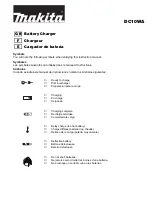
Standard Battery Parameters
3
.
7V
/
cell
3
.
7V
/
cell
4
.
2V
/
cell
3
.
8V
/
cell
≦
1C
3
.
6V
/
cell
4
.
1V
/
cell
≦
1C
3
.
3V
/
cell
3
.
6V
/
cell
3
.
3V
/
cell
≦
4C
3
.
0
-
3
.
3V
/
cell 2
.
9
-
3
.
2V
/
cell 2
.
6
-
2
.
9V
/
cell
1
.
2V
/
cell
1
.
5V
/
cell
n
/
a
1C
-
2C
1
.
2V
/
cell
1
.
5V
/
cell
n
/
a
1C
-
2C
2
.
0V
/
cell
2
.
46V
/
cell
n
/
a
≦
0
.
4C
0
.
1
-
1
.
1V
/
cell 0
.
1
-
1
.
1V
/
cell
1
.
8V
/
cell
3
.
7V
/
cell
4
.
35V
/
cell
3
.
85V
/
cell
≦
1C
3
.
1
-
3
.
4V
/
cell
WARNING AND SAFETY NOTES
Never attempt to charge or discharge the following types of
batteries.
●
A battery pack, which consists of different types of cells (including different
manufacturers)
●
A battery that is already fully charged or just slightly dis charged.
●
Non-rechargeable batteries (Explosion hazard).
●
A faulty or damaged battery.
●
A battery fitted with an integral charge circuit or a protection circuit.
●
Batteries installed in a device or which are electrically linked to other
components.
●
Batteries that are not expressly stated by the manufacturer to be suitable
for the currents the charger delivers during the charge process.
Please bear in mind the following points before commencing
charging:
●
Did you select the appropriate program suitable for the type of battery you
are charging?
●
Did you set up adequate current for charging or discharging?
●
Have you checked the battery voltage? Lithium battery packs can
be wired in parallel and in series, i.e. a 2 cell pack can be 3.7V (in parallel) or 7.4V
(in series).
●
Have you checked that all connections are firm and secure? Make sure there
are no intermittent contacts at any point in the circuit.
Nominal
Voltage
Max
Charge
Voltage
Storage
Voltage
Allowable
Fast
Charge
Min
.
Discharge
Voltage
LiPo
LiIon
LiFe
NiCd
MiMH
Pb
LiHV
※
Be very careful to choose the correct voltage for different types of battery
otherwise you may cause damage to the batteries. Incorrect settings
could cause the cells to fire or Explode.
07










































